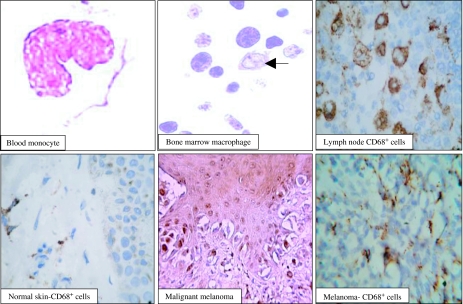Figure 2.
Morphological features of monocytes and macrophages in the peripheral blood, bone marrow, lymph node, normal skin and malignant melanomas. The immune system represents a complex network of cells collectively known as immune cells (such as macrophages) and organs (such as lymph nodes) that work together to defend the body against foreign substances (antigens) such as tumour cell. The immune cells are scattered throughout the body either as isolated cells or as non-encapsulated aggregations of cells in the skin, respiratory and other systems. The blood monocyte is the largest normal white cell found in the blood. It has an irregular lobulated nucleus and opaque grey-blue cytoplasm containing fine granules and irregular outlines. The bone marrow monocyte (arrow) has vesicular nuclei and abundant faint blue cytoplasm. In the lymph nodes, the macrophages occupy the sinuses and have positive reactivity for CD68. In normal skin, macrophage are found either singly or around the blood vessels (CD68+ cells). In melanomas, the content of macrophages (CD68+ cells) is about 3–7%.

